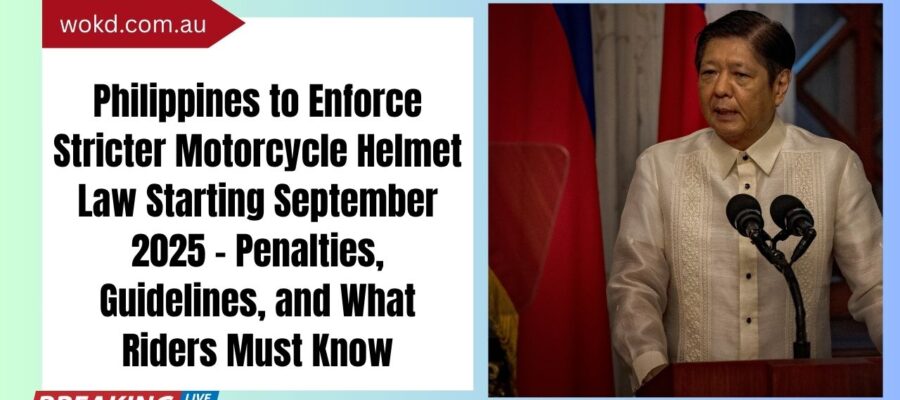Starting September 2025, the Philippine government will begin nationwide enforcement of an updated Motorcycle Helmet Act, introducing stricter penalties, clearer compliance requirements, and heightened roadside checks.
The move aims to strengthen road safety, reduce head injuries, and ensure that all motorcycle riders and back riders are using certified, standard-compliant helmets.
In this article, we outline everything you need to know about the revised helmet law, including fine amounts, what constitutes a compliant helmet, who must comply, and what to expect starting September 2025.
What Is the Motorcycle Helmet Law in the Philippines?
The Motorcycle Helmet Act of 2009 (RA 10054) requires all motorcycle riders and passengers to wear a standard protective helmet at all times while driving on any road or highway. The law is based on:
- Republic Act 10054
- DOTr and LTO implementing rules and regulations (IRR)
- DTI regulations regarding safety standards
The 2025 enforcement update introduces automated monitoring, higher penalties for repeated violations, and a public awareness campaign ahead of the rollout.
Who Must Comply with the Updated Helmet Law?
The helmet law applies to all motorcycle drivers and passengers, regardless of trip distance, location (urban or rural), or age.
Mandatory Helmet Use Applies To
| Category | Required? |
|---|---|
| Motorcycle riders (driver) | Yes |
| Back riders/passengers | Yes |
| Delivery drivers (e.g., food, courier) | Yes |
| Riders on private property or village roads | No (unless road is public) |
Children are also required to wear helmets if riding as passengers, provided they meet the minimum height and safety regulations.
What Is a Compliant Helmet?
Only helmets bearing the DTI Standard (PS or ICC sticker) are considered compliant. Helmets must meet the Philippine National Standards (PNS/UNECE 22:05 or higher) to ensure proper protection during accidents.
Key Features of a Compliant Helmet
- Full-face or half-face shell
- Clear visor or face shield
- Firm chin strap with buckle
- DTI PS or ICC sticker (inside or outside the helmet)
- Free from cracks, damage, or unauthorized modifications
Non-standard helmets, including bicycle helmets, construction hard hats, and novelty headgear, are not allowed.
Helmet Law Penalties Starting September 2025
The Land Transportation Office (LTO) has updated its fine structure and enforcement procedures to reflect the 2025 rollout.
Penalty Table for Helmet Violations
| Offense | Penalty |
|---|---|
| 1st offense | ₱1,500 fine |
| 2nd offense | ₱3,000 fine |
| 3rd offense | ₱5,000 fine + license suspension |
| 4th offense | ₱10,000 fine + license revocation |
Repeat offenders may be required to attend a road safety seminar or face temporary confiscation of their vehicle or license.
Timeline and Implementation Details
The helmet law isn’t new—but the 2025 enforcement campaign introduces automated roadside monitoring, random checkpoints, and a centralized helmet compliance database.
Key Implementation Dates
| Phase | Date |
|---|---|
| Public Information Campaign | July – August 2025 |
| Start of Nationwide Enforcement | September 1, 2025 |
| Evaluation and Feedback Review | December 2025 |
Expect heightened LTO presence, random inspections, and fines issued on the spot beginning in September.
What Motorcyclists Should Expect
Starting September 2025, you should prepare for the following:
- Increased LTO checkpoints, especially near schools, highways, and urban centers
- Spot inspections of helmet quality and DTI compliance
- On-the-spot issuance of fines or confiscation notices
- Requirement to present a valid OR/CR and driver’s license
Riders should also be prepared to show proof of helmet purchase (receipt or certification) if requested.
How to Ensure Compliance
Steps to Take Before September 2025
- Inspect your current helmet for DTI PS or ICC sticker
- Replace helmets with cracks, loose straps, or missing certification
- Purchase from authorized helmet dealers with verifiable receipts
- Attend LTO or LGU seminars (optional but recommended for awareness)
For DTI sticker validation, visit your nearest DTI regional office or check via official mobile verification apps.
The full enforcement of the Motorcycle Helmet Law beginning September 2025 is a vital push toward reducing fatalities and improving road discipline among motorcycle users.
With stricter penalties, enhanced monitoring, and a strong push for safety, it’s crucial for all riders to check their helmet quality and legality now.
Avoid fines and stay protected—comply with the updated helmet regulations before the law takes full effect.
Frequently Asked Questions
Q1: Can I use a second-hand helmet if it still looks good?
It’s not recommended. Helmets lose integrity over time, especially after impacts. Only use helmets with valid DTI stickers and no damage.
Q2: Are bicycle helmets acceptable for short motorcycle trips?
No. Bicycle helmets do not meet DTI safety standards for motorcycle use. Only DTI-approved helmets are legally allowed.
Q3: What if I forgot my helmet on a quick errand—can I just walk the motorcycle?
No. Operating or riding a motorcycle on a public road without a helmet is a violation, regardless of distance or speed.

